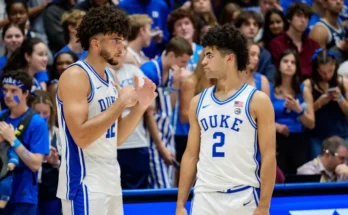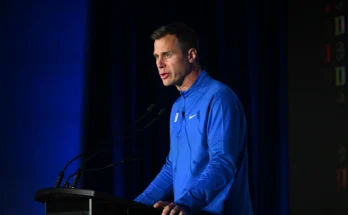Oilers Make New Emergency Roster Moves Amid Injury Crisis
The Edmonton Oilers have entered a critical juncture in their season, not because of a standings slump or a locker room controversy, but due to an injury crisis that has forced the team into making emergency roster moves. With key players sidelined and postseason aspirations on the line, General Manager Ken Holland and the front office are taking swift and strategic action to patch up the roster while maintaining competitive firepower. The most recent moves reveal just how serious the situation is—and how much trust the organization is placing in its depth and developmental system.
At the center of this shuffle is the unexpected call-up of 6-foot-5 center James Stefan, who was playing for the Oilers’ AHL affiliate, the Bakersfield Condors. The 22-year-old wasn’t projected to make an NHL appearance this season, but injuries to pivotal forwards, including Ryan McLeod and Mattias Janmark, opened a sudden vacancy in the bottom-six forward group. Stefan, known more for his two-way play and faceoff ability than explosive scoring, finds himself thrust into a spotlight much earlier than anticipated.
His promotion highlights the dual role that development programs play for contending NHL franchises like Edmonton. While most attention is given to marquee names such as Connor McDavid and Leon Draisaitl, teams ultimately live or die by the quality of their depth. When attrition strikes—and it inevitably does in the long grind of an NHL season—players like Stefan become not just stopgaps, but potential postseason x-factors.
The Oilers are no strangers to making late-season adjustments. Over the last several years, the team has grown increasingly adept at managing their roster with precision, aided by both their analytics team and a strong understanding of player readiness. However, this most recent wave of injuries is perhaps their most challenging to date. The absence of McLeod, a key piece on the penalty kill and a versatile third-liner, leaves a significant void in Edmonton’s transition game. Janmark’s status adds another layer of concern, especially given his ability to play both wings and anchor defensive zone shifts.
To navigate these absences, Edmonton didn’t just stop at calling up Stefan. Defenseman Philip Kemp, another Condors regular, has also joined the team on an emergency basis. Kemp, a reliable stay-at-home defenseman, may see limited minutes depending on matchups but provides a much-needed safety net as the team battles through a congested and physical schedule. The Oilers coaching staff, led by Kris Knoblauch, has already signaled its willingness to tweak pairings and experiment with new line combinations—both up front and on the blue line.
The sense of urgency is palpable. With the Pacific Division standings tightly contested and playoff seeding still up for grabs, every game carries postseason implications. The Oilers can ill afford a drop-off in performance, especially as they try to secure home-ice advantage in the first round. Bringing in younger players like Stefan and Kemp isn’t just about short-term survival; it’s a strategic gamble that could pay dividends by injecting fresh legs and hunger into the lineup.
What’s more, these moves underscore Edmonton’s broader organizational philosophy—a belief in developing talent in-house rather than simply relying on trade deadlines and rental players. In a league increasingly shaped by cap constraints and long-term planning, the ability to draw from within the system is a hallmark of sustainable success. The Oilers, once notorious for rushed development and mismanagement of young talent, appear to be learning from past mistakes. Stefan’s call-up is seen internally as a reward for hard work and consistency, rather than a panic button.
Behind the scenes, the mood is focused but not frantic. Connor McDavid has reportedly been a vocal presence in the locker room, ensuring that the team remains steady despite the sudden changes. His leadership, often overshadowed by his on-ice brilliance, is now coming to the fore at a crucial time. Meanwhile, Draisaitl continues to shoulder a heavier load, both offensively and in terms of taking key faceoffs with McLeod unavailable. Their partnership will be essential as Edmonton looks to maintain its scoring pace despite lineup adjustments.
Goaltending, too, becomes even more vital in this stretch. Stuart Skinner has quietly put together a solid season and will be relied upon heavily as the team weathers the injury storm. His ability to deliver consistent performances gives the team a margin of error as the new additions find their footing. Backup Calvin Pickard may also see some action, especially if matchups allow for load management or if any further setbacks occur.
Of course, the risk in all of this is chemistry disruption. Hockey teams often rely on finely tuned lineups, where understanding and timing are everything. Plugging in new players—especially those without NHL experience—can throw off rhythm and communication. But the Oilers are hopeful that their current leadership group, along with a positive locker room culture, can mitigate these challenges.
What’s particularly interesting is the opportunity this presents for Stefan. A standout during his junior career and a steady presence in the AHL this year, he’s long been considered a “project” player with a high hockey IQ and above-average anticipation skills. He’s not expected to rack up points, but if he can win faceoffs, disrupt opposing lines, and keep possession metrics in the black, he will be fulfilling exactly what the Oilers need from him.
Similarly, Kemp’s presence allows Knoblauch the flexibility to deploy him in specific defensive situations, such as late-game penalty kills or shifts against physically imposing teams. While he may not light up the scoresheet, the Oilers will be content if he can keep the puck out of their net and make smart, low-risk plays.
While fans may have preferred splashier names or high-profile call-ups, these emergency moves are deeply strategic. The Oilers are playing the long game. They are trusting their system, their development pipeline, and their locker room leadership to steer through rough waters. It’s a belief in culture and preparation over panic, and it speaks volumes about how the franchise views itself in this championship window.
Still, there’s an unmistakable pressure that comes with these decisions. Should the team falter in upcoming games, questions will be asked—about readiness, about front office planning, and about whether this roster has the durability to withstand playoff-level physicality. Conversely, if these call-ups contribute in even modest ways to victories, the Oilers will emerge with validation that their holistic approach is bearing fruit.
The next stretch of games will be revealing. Edmonton’s schedule doesn’t offer much breathing room, with several high-stakes matchups looming against divisional foes and playoff-bound teams. The coaching staff has already begun adjusting systems slightly, focusing on defensive compactness and clean breakouts to make life easier for the newcomers. It’s a sign that the Oilers are not just reacting—they’re adapting.
In many ways, this moment serves as a microcosm of modern NHL roster building: part science, part gamble, and always at the mercy of health. The Oilers have placed their bets, and now it’s time to see how the pieces fall. They’ve built a contender, and contenders must find ways to win under adverse circumstances.
For James Stefan and Philip Kemp, the moment is now. For the Oilers, the mission is clear—weather the storm, hold the line, and keep their eyes on the bigger prize. Because in this league, resilience isn’t just a buzzword. It’s the difference between a promising season and a deep playoff run.



